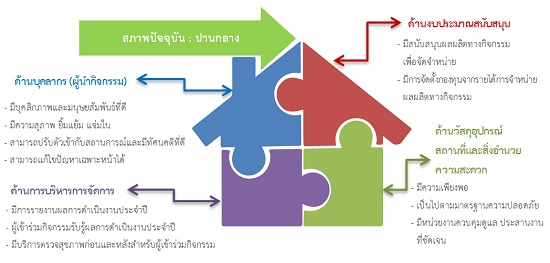A STUDY OF PHYSICAL FITNESS AND PHYSICAL WELL-BEING QUALITY OF ELDERLY PEOPLE IN MUEANG CHANTHABURI DISTRICT, CHANTHABURI PROVINCE
DOI:
https://doi.org/10.14456/nrru-rdi.2023.50Keywords:
Physical fitness, Physical well-being quality, Needs for physical activity and recreation, Elderly peopleAbstract
The preparation of activities aimed at creating good health characteristics for post-retirement individuals led to a research study focusing on the current conditions, and physical well-being needs of the elderly in Mueang Chanthaburi District, Chanthaburi Province. A sample group of 351 cases was selected using a two-stage random sampling method. Data collection was carried out through questionnaires with a reliability coefficient of 0.93, collected in each Sub-district for convenience and analyzed using statistical methods; percentages, averages, and standard deviations. The research findings revealed that the majority of the sample group had 1-2 days of free time for physical activities per week (51.85%), often with uncertain scheduling or depending on the availability of free time (35.33%), and typically spending about 60 minutes per activity session (36.75%). The most significant need identified was for increased physical activities (24.50%), primarily motivated by a desire to stay healthy (29.63%). In terms of physical fitness and physical well-being quality, the sample group was found to be at a moderate level (M=3.19, S.D.=0.49). However, they had the highest level of need for physical fitness and quality of life (M=4.99, S.D.=0.10). This data is valuable for creating physical fitness programs involving exercise activities relevant to the happiness and good health of the elderly, which are suitable, safe, and promote daily routines in accordance with the environmental context of the elderly in the area for long-term effectiveness.
References
Aloulou, H., Aloulou, H., Abdulrazak, B., & Kacem, A. H. (2023). Personalized, context-aware, and adaptable persuasive approach for encouraging physical activity among older adults. Entertainment Computing, 46, 100567. https://doi.org/10.1016/j.entcom.2023.100567
Bangmo, S. (2015). Organization and Management (7th ed.). Bangkok : Witthayapat. (In Thai)
Best, J. W. (1993). Research in Education. Boston MA : Allyn and Bacon.
Bunchai, K. (1997). Basic Kinesiology. Bangkok : Kasetsart University Publishing House. (In Thai)
Chaichompoo, P. (2022). Physical Literacy and Physical Activities Among Older Persons with Hypertension. Thesis, Master of Nursing Science Program in Gerontological Nurse Practitioner, Chaing Mai University, Chaing Mai. (In Thai)
Cronbach, L. J. (1990). Essentials of psychological testing (5th ed.). New York : Harper Collins Publishers.
Department of Physical Education. (n.d.). Recreation is a way of life. N. P. : Department of Physical Education, Ministry of Tourism and Sports. (In Thai)
Ekkapalakorn, W., Phatcharoen, H., & Satiannoppakao, W. (2021). Survey of Thai people's health by physical examination, No. 6, 2019-2020. Nonthaburi : Health Systems Research Institute. (In Thai)
Institute for Population and Social Research, Mahidol University. (2020). Regenerating physical activity in Thailand after COVID-19 pandemic. Nakhon Pathom : Parbpim. (In Thai)
Ishoh, A. (2019). Qualityof Lifeof People in TambonSakom Administrative Organization, Thepha District, Songkhla Province. Thesis, Master of Public Administration Program in Public Administration, Prince of Songklan University, Songkla. (In Thai)
Jensantikul, N. (2023). Social Welfare for Thailand’s Elderly: Policy Perspectives and Proposals for Co-production. Asia Social Issues, 16(3), e253814-e253814. https://doi.org/10.48048/asi.2023.253814
Khunkaew, A. (2023). Selection of basic and advanced statistics for research Basic agreement test data analysis and presentation of results. Bangkok : Chulalongkorn University Press. (In Thai)
Likert, R. (1961). New Pattern of Management. New York : McGraw-Hill.
Office of Sports and Recreation Development. (2002). Physical fitness testing and assessment. Bangkok : Religion Publishing House. (In Thai)
Physical Activity Division for Health, Department of Health, Ministry of Public Health (2018). Thailand Recommendations on Physical Activity, Non-Sedentary Lifestyles and Sleeping for Elderly (Age 60 years and over). Bangkok : NC Concept. (In Thai)
Son, J. S., Nimrod, G., West, S. T., Janke, M. C., Liechty, T., & Naar, J. J. (2021). Promoting older adults’ physical activity and social well-being during COVID-19. Leisure Sciences, 43(1-2), 287-294. https://doi.org/10.1080/01490400.2020.1774015
Thawornthaweewong, S. (1990). Basic sociology and anthropology. Bangkok : King Chan Press. (In Thai)
The Bureau Of Registration Administration, Department of Provincial Administration. (2022). Management information system: Provincial population statistics, September 2022, according to age range 60 years to 65 years. Retrieved January 14, 2023, from https://stat.bora.dopa.go.th/StatMIS/#/ReportStat/3 (In Thai)
Tirakanun, S. (2014). Social science research methods: guidelines for practice (12th ed.). Bangkok : Chulalongkorn University Press. (In Thai)
United Nations. (2019). 2019 UNIDOP Celebrates “The Journey to Age Equality”. New York : United Nations.
Wangler, J., & Jansky, M. (2023). Promotion of Exercise and Health for Older People in Primary Care: A Qualitative Study on the Potential, Experiences and Strategies of General Practitioners in Germany. Journal of Prevention, 1-14. https://doi.org/10.1007/s10935-023-00730-6
World Health Organization. (2010). Global Recommendations on Physical Activity for Health. Geneva : World Health Organization.

Downloads
Published
How to Cite
Issue
Section
License

This work is licensed under a Creative Commons Attribution-NonCommercial-NoDerivatives 4.0 International License.



